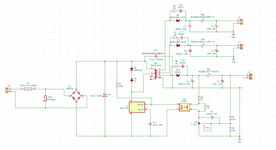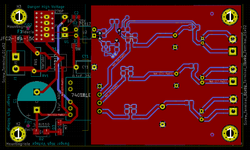Embedded_Geek
Full Member level 6
Hello Members,
I made a Flyback SMPS with Myrra 74015 transformer and TNY276 control chip. Unfortunately I see that when input voltage is 230VAC the output it not the expected voltage. But when I reduce the input AC volatage to approx. 120VAC then I get the correct expected output voltage.
Could you please point to the possible reasons for this behaviour. I have attached the screenshot of the schematics.
Many thanks,
Embedded_Geek
I made a Flyback SMPS with Myrra 74015 transformer and TNY276 control chip. Unfortunately I see that when input voltage is 230VAC the output it not the expected voltage. But when I reduce the input AC volatage to approx. 120VAC then I get the correct expected output voltage.
Could you please point to the possible reasons for this behaviour. I have attached the screenshot of the schematics.
Many thanks,
Embedded_Geek

